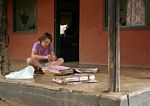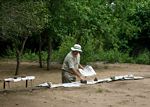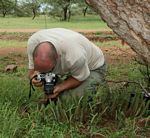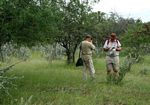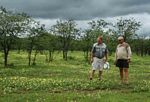Expedition no. 4: Expedition to Tuli (via Bulawayo): 22 Dec 2007-1 Jan 2008
A 10 day expedition to the Tuli area in the extreme south of Zimbabwe, via Maleme Dam and Bulawayo.
Photo: Bart Wursten
Petra Ballings pressing plants outside our hut at the Shashe Wilderness Camp, Tuli.
Photo: Petra Ballings
Mark Hyde attempting to dry newspaper one rather cloudy day at the Shashe Wilderness Camp.
Generate a list of species for Expedition no. 4
Description
Off we go! 22 December 2007
It has been a while since the Zimbabwe Flora Team (Mark Hyde, Bart Wursten and Petra Ballings) got the chance to go on a botanizing expedition but around Christmas all parties involved were able to free themselves. After much umm-ing & aah-ing it was decided to travel to the Tuli area, tucked away in one of the most remote and untouched corners of the country. As planned, we were ready to leave Harare at about 9 o'clock. And luck was smiling in the form of bright sunshine, which had not been seen in quite some time, it being the wettest December in years.
Our plan for the first day was to get to Matobo National Park, about 480 km from Harare, at least a 6 hour drive by any standards and certainly ignoring all the interesting vegetation on the way. We had a brief stop at the Golden Mile Motel for a quick drink & toilet break and made our first plant-discovery in the form of some nicely naturalized specimens of Cannabis sativa, growing in the flower beds by the front entrance.
Just outside Kwekwe our tummies told us it was way past lunchtime. It was impossible not to take time to look at the roadside vegetation. Some of the more interesting finds included the Euphorbia related nettle Tragia okanyua, a handsome but so far unidentified Vigna (since determined as Otoptera burchellii) and a most spectacular maroon colour form of our National Flower Gloriosa superba, better known as the Flame-lily. We also included some specimens of the alien but quite unusual weed Zinnia peruviana.
The day passing quickly, we only got tempted to stop one more time when our eyes were caught by large patches of blue flowers covering the ground below the dry mixed Mopane-Acacia scrub. These turned out to be thousands of very pretty Craterostigma plantagineum specimens, mixed with some minute but lovely plants of Xerophyta humilis. Despite lovely, sheer endless fields of Moraea natalensis and Cycnium tubulosum, we moved on and reached Bulawayo in the late afternoon, stretched our legs and made it to Matobo just in time before the closing of the gate.
Maleme Rest Camp offered us a basic but very comfortable chalet for the first night and as we even had the rare comfort of electricity, we downloaded our yield of photos, compiled our record lists and pressed our plants, ready for the next day of botanizing.
Matobo N.P.: 23 December 2007
After moving from the simple chalet to the relative luxury of a fully equipped cottage, we spent the morning foraging in and around the Rest Camp, which is situated right among the rocky outcrops, the Matobo Hills are so famous for.
Many of the Matobo specials were growing on our doorstep. Gymnosporia matobensis is a small shrub or slender tree, armed with straight needle-like spines and small oblanceolate leaves in clusters. It is a true Zimbabwe endemic, only found in the larger Matobo area. Strychnos matopensis, though not endemic (it is also known from limited areas in Mozambique and Zambia), has also been named for these hills. An elegant and handsome, climbing liana-like plant, it has interesting coiled woody tendrils and strictly opposite leaves and branches.
Another distinct feature of this boulder-stacked habitat is Ochna glauca with its small blue-green leaves and red fruits. It is found in this part of Zimbabwe, only just extending across the borders into Botswana and South Africa. With its very limited distribution it would surely qualify as a near-endemic.
Our timing was perfect to find the pretty Turraea obtusifolia or Small Honeysuckle-tree in full flower as well as the magnificent citrus relative Calodendrum capense with its beautiful large heads of pink flowers. This type of environment is not particularly rich in ferns but fern-lover Petra was rewarded with typical rock-lovers such as Cheilanthes involuta, Cheilanthes viridis and Doryopteris concolor.
Just outside the camp in front of the National Park offices, a small grassy vlei was alive with hundreds of butterflies, all going wild over an exotic purple-flowered Verbena weed. It is one of the typical "twin-weeds" in our flora. Two very similar species, which originally were probably well separated in their home-countries, have thrived as problem weeds after their accidental introduction. Now, both species grow together throughout the tropics and it is very difficult if not almost impossible to distinguish Verbena bonariensis and V. brasiliensis.
The afternoon was spend at the nearby Maleme Dam. One of our main rewards was the extraordinary stapeliad Orbea caudata subsp. rhodesiana, bearing several striking but very foul-smelling flowers. These succulents attract flies as their pollinators and, as we all know, flies do not go for the pleasant odours in nature.
Nearby we found Cleome oxyphylla, an attractive and uncommon relative of the widespread Purple Mouse-whiskers Cleome hirta. The campsite itself had not been slashed for some time, which suited us quite well. Another alien weed, Ambrosia maritima, got our attention. Although so far only recorded as an unusual introduction in the Eastern Division, it was very common here and thus a new record for the Western Division.
Petra added another fern to her list, the uncommon Asplenium cordatum with its undersides densely covered in scales.
Before calling it a day we had to climb back up on the steep entrance road, where we saw another Honeysuckle-tree, Turraea floribunda. It certainly lived up to it scientific name-tag and showed us masses of flowers. These appear before the leaves have developed, which made the shrub even more striking.
Over the obligatory G&T sun-downer, we contemplated that we had a fruitful and very pleasant stay in Matobo. The accommodation was well maintained and clean and all facilities were present and in working order. The staff at Maleme were very friendly and helpful and deserve our gratitude and respect. They still showed pride in "their" National Park and have not lost motivation as would be so easy to do in these difficult circumstances.
Getting to Tuli: 24 December 2007
The day started as one of those you don't want to think about and just want to get over with. We had to get back to Bulawayo for some essential shopping, fuel and money. Finding the basics these days may take hours of moving from store to store and still be in vain; another currency change right over the Christmas holidays complicating matters even more. However, we were fortunate. Just outside the city we stopped at a small shopping centre with no more than two stores, a bottle store and a few outside vendors.
We went into one of the tiny shops, without too much hope of finding our "most wanted" items, but were amazed in acquiring delicious freshly baked bread rolls. Stroke of luck no. 2 was that we could pay by cheque. What we thought would be morning full of frustrations turned out to be dealt with in half an hour. We were less lucky with fuel, the queue at the Caltex garage was just too long, We did have an ample spare supply, however, which should get us back to Bulawayo so off we went.
The landscape slowly changed from rocky hills to flat open woodland. We gave ourselves little time to stop as most of what we saw on the way could be expected to be found at our destination. The last stretch of road was in pretty bad condition and our car started to produce some rather unhealthy grinding noises from the left front wheel, which gradually became louder and more persistent. When we finally arrived, it was with some relief but also with a definite sense of doubt whether we would be able to get back to civilization from this remote place.
Tuli: 25, 26, 27, 28 December 2007
Though marked on most maps as a true village, Tuli consists of little more than a police post, surrounded by vast expanses of near empty scrubland, dominated by the well-known Colophospermum mopane, Terminalia prunoides and several equally undemanding cousins in the genus Commiphora.
It was particularly C. tenuipetiolata, with its small, hairless 3-foliolate leaves and long slender petioles, that got our attention. It is fairly widespread in Namibia and southern Angola while a separate population has a limited distribution in northern South Africa, just entering the extreme South of Zimbabwe. A rarely seen "special" for us indeed. Two other species, C. glandulosa and C. viminea, belong to the few species in this family with apparently simple leaves. The latter also stands out with its conspicuously black-and-white banded bark, which earned it the appropriate English name Zebra-bark Corkwood.
Less than a kilometer further, the Shashe River marks what should be, by any other logic, the border with neighbouring Botswana, weren't it for some bizarre historical twist carving out the "Tuli-Circle" on the opposite bank and planting the Zimbabwean flag. On the banks of the river, Wildlife & Environment Zimbabwe, long ago built a small camp, where members and non-members can stay to enjoy the natural beauty and tranquility of the area in shade of majestic riverine trees like Ficus sycamorus, Faidherbia albida and Xanthocercis zambesiaca. This last species belongs to the large and well-known pod-bearing family Fabaceae but apparently fills the role of the proverbial exception that supposedly proves the rule, because it has fleshy, berry-like fruits that do not resemble pods in any way whatsoever.
Most of the year the soils appear to be a dry and barren resort, suitable only to hardy succulents like Sesamothamnus lugardii, Euphorbia cooperi, Aloe chabaudii, Stapelia gigantea or the grotesque Adenia spinosa. However, an often brief and meagre season of rains, temporarily transforms the earth into a colourful garden of eager and short-lived flowers, resembling some painting by Van Gogh on one of his wilder days. Carpets of yellow Tribulus zeyheri are mixed with the bright orange-red bells of Hermannia kirkii, deep pink heads of Indigofera holubii and many others. Tribulus zeyheri shares the prostrate habit, the imparipinnate leaves and the hard 3-thorned fruits with its close relative, the well-known and widespread T. terrestris or Devil's thorn. T. zeyheri has much larger and more attractive yellow flowers and is only very locally common in the far South of the country. The spiny fruits of both species have the persistent habit of attaching themselves to animal hooves, soles of boots and even car tyres. This aids dispersal of the seeds and also serves as a very good warning not to go botanizing barefoot. Most of the time was spend botanizing close around the camp. We walked along the river, in the grasslands, climbed a few low hills, walked through dry riverbeds and found it extremely fascinating to be in an area so different from what we, coming from Vumba, are used to.
The wetter periods during our stay mostly involved moving the furniture around the many leaks in the roof, while helping hands were offered in getting our car back in shape by the friendly and helpful Johan, who, with his wife Mary manages one of the hunting camps across the river. They were stranded with us in camp, their car being stuck on the other side of the unusually flooded and impassable Shashe River. Johan was definitely more mechanically inclined than us botanists and he had many hours of fun, taking the front wheel apart, applying some frightening "bush-mechanics' including using an old concrete nail to temporarily solve our problem....Don't ask!
Back to Bulawayo: 29 December 2007
A rather suspenseful day of travel since we could only hope our car would make it back to Bulawayo with all four wheels attached. Especially since it as being more overloaded than ever. Although it should have been a bit lighter after eating our way through some of the supplies, we were probably carrying double the weight. Johan and Mary still had their car stranded on the other side of the Shashe, which was showing no signs of becoming passable. After their help with getting our car movable again, we decided we could return the favour by taking them and their luggage with us to Bulawayo. Johan appeared to be confident his craftsmanship with our wheel would hold and reassured us that, if there was a problem, he had some tools at hand. He also showed us an alternative route, which evaded most of the horrible corrugations we had endured on the way in. It actually showed us some slightly different, more rocky places and yielded some more interesting plant-records including a stunning specimen of Stapelia gettliffei with large starfish-like flowers fringed with long purple hairs. Interestingly, one of the more fascinating discoveries was an attractively violet-flowered but horrendously spiny species of Central American cactus, we identified as Opuntia fulgida. Though not recorded as such before, it was definitely well naturalized in the area and even becoming worryingly invasive in places.
And yes, we did make it, reaching Bulawayo with all four wheels still firmly in place. We safely delivered Johan & Mary at their destination and made our way to Francis Day, who very kindly took us in from the streets of Bulawayo.
Bulawayo: 30 & 31 December 2007
We did get a bit stranded with still no diesel at Caltex and great shortages of money. Where else but in Zimbabwe. A day of enforced relaxation was called for and finally at last, through un-publishable sources, we managed to find some 60 liters of indispensable liquid.
After clearing that logistical headache we decided that an outing to the Hillside Dams was in order. It is an interesting mixture of somewhat neglected and overgrown rock-gardens and indigenous rocky woodland surrounding two old water supply dams. The area is being restored into a safe and pleasant recreational park by some very admirable Bulawayo citizens. For more information on this excellent project, check out their website: http://www.hillsidedams.com/.
The last evening of this rather eventful year was spent on the veranda of Francis Day's Bulawayo home, listening to frogs, crickets and the occasional distant fireworks, while dishing out on some delicious snacks and contemplating what the coming year will have in store for us!
Petra BallingsBart Wursten
